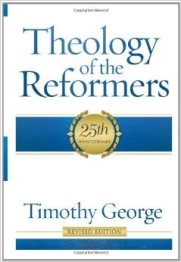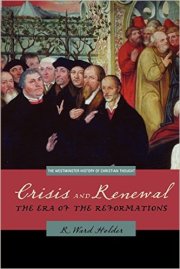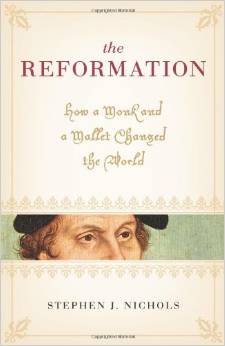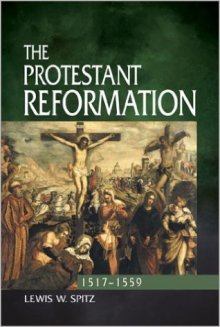Timothy George. Theology of the Reformers. Nashville, TN: B&H Publishing Group, 2013. 428. $29.99.

It is in some people’s nature to constantly desire change. There are some that are not content unless they are seeking after a more correct or more efficient way of doing things. Those involved in the religious Reformation of the 1500s all had different ideas about what exactly needed change, but they all agreed that religious change was necessary. Theology of the Reformers by Timothy George is a very practical book about the theological ideas of the leaders of this Reformation. He argues that an understanding of Reformation theology is key to an understanding of the church and the “Christian story” (1). George’s understanding of the Reformation is that is was simultaneously “a revival and a revolution” (17). Because George sees the Reformation as a religious event with primarily theological concerns, he focuses on the “theological self-understanding” of five principle reformers: Martin Luther, Huldrych Zwingli, John Calvin, Menno Simons, and William Tyndale. He sets out to provide a foundation upon which to dialogue with them in order to form one’s own opinions and questions (16). As a former professor of History and Doctrine and Dean at Southern Baptist Theological Seminary as well as Beeson Divinity School, Timothy George is uniquely qualified to write this book. He is a prolific writer and served as the editor of the Reformation Commentary on Scripture. As an Evangelical Christian, George approaches this study as historical theology with an emphasis on understanding the story of the church better for the purpose of both admiration and emulation.
This book contains eight chapters each centered on a different topic. George introduces his book with an overview of different methods of studying the Reformation so that he can center in on his focus on the Reformation as a religious transitional period. This is followed by an exploration in chapter two of the theology of the late Middle Ages, the stage of history immediately preceding the Reformation. In discussing the Middle Ages, he focuses on the deep sense of “moral anxiety” and guilt in that era (24). The theological focus in this time was largely on human guilt and a wrathful God that “placed an intolerable burden on the penitent” (26). This laid an excellent foundation for religious change, which George outlines in the next five chapters, each focused on a different key reformer and their theology.
The next five chapters of George’s book focus in on the major reformers and their theology. The third chapter of the book is centered on Martin Luther, a German pastor and scholar who was above all deeply committed to the Word of God and to the Church. His theology was profoundly biblical and practical as he wrote contextually “to particular situations with definite ends in mind” (57). His legacy is most certainly his deep understanding of the centrality of Christ born in the midst of his deep sufferings. The next reformer spoken of is Huldrych Zwingli, a Swiss parish priest and patriot. Zwingli’s primary concern was to unite the political and religious realms, believing firmly that “the kingdom of Christ is also external” (115). He was also deeply committed to God’s word and very cautious to maintain the strict “distinction between the Creator and all creatures” in order to avoid the great sin of idolatry (125). Chapter five is centered on John Calvin, the second-generation French reformer best known for his work in Geneva. Calvin’s greatest contribution to the Reformation, according to George, was that of creating a “clear, systematic exposition” of the Reformation ideas, largely through his Institutes (174). Calvin’s theology was centered on the glory of God and the teaching of Scripture.
George then moves his attention to the Radical Reformation as a whole, focusing on Menno Simons, perhaps the most well known of the radicals. After a struggle through the Gospel, George contends that Simons became committed to 1 Corinthians 3:11, “the motto of his life and his theology” (278). The Anabaptist leader emphasized new birth, biblical authority, and a Christocentric reading of Scripture. The last reformer that George speaks of is William Tyndale, the English reformer known for translating the Bible into English. This chapter is a new addition to the 25th Anniversary Edition of The Theology of the Reformers. Tyndale’s theology, centered on the centrality of Scripture, love of neighbor, and rich ecclesiology, was developed on the run until his untimely martyrdom. George’s last chapter summarizes what he views to be why the Reformation matters today, largely by pointing out that the Reformation, “challenges the church to listen reverently and obediently to what God as once and for all said and once and for all done in Jesus Christ” (379). George cites a wide variety of primary and secondary sources throughout his book, giving ample bibliographies at the close of each chapter.
George accomplishes his goal of providing the theology of the Reformers in order to promote learning from them. Each chapter gives a short biography of the reformer being spoken of and then moves into a succinct explanation of their main works and major theological ideas. His masterful use of quotations both by and about these reformers help to give a holistic view of them and their theology. Each chapter also builds on the others by comparing and contrasting the different reformers theological ideas and methods of reform. By doing this, George not only touches on their similarities and differences, he also gives an understanding of them as people, thus giving greater fodder for our admiration and emulation of them. Although George did use several primary sources and quoted them occasionally, it would be helpful to see more extensive usage of the reformers own words to describe their theology.
In Theology of the Reformers, Timothy George masterfully walks through the thinking of the Reformers in order to provide a framework for the church today to think about theology. He convincingly shows that we not only should learn from the reformers as historical Christian figures, but also recognize that studying their theology can help us “serve the true and living God of Jesus Christ” more fully (379). George’s broad brushstrokes makes the book more accessible for a wider audience. It would further enhance the book, however, to give more room for the reformers to have more of a say in their own theology. Because of the lack of primary source quotations, this book is probably most helpful for a beginning student of the Reformation to give them a brief overview of Reformation theological thought, or for a more advanced student that would like a quick review.
Brianna Smith, Biola University


